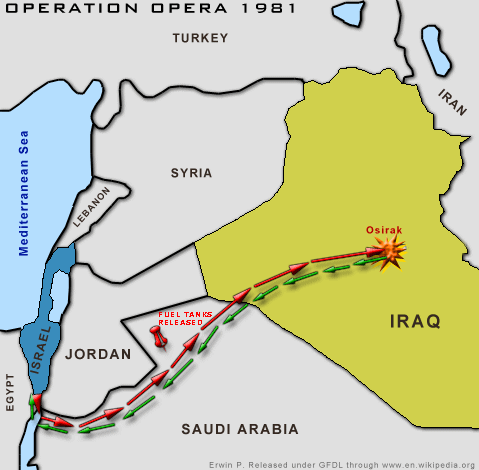On 7 June 1981, Israel executed a brilliantly planned and perfectly executed attack on an Iraqi nuclear reactor that was likely weeks from becoming operational.



+++++++++++++++++++++++++++++++++++++++++++++++++++++++++++++++++++++++
 Operational Planning
Operational PlanningThe distance between Israeli military bases and the reactor site was significant—over 1,600 km (990 mi). The Israeli planes would have to violate Jordanian and/or Saudi airspace in a covert flight over foreign territory, making mid-air refueling unfeasible. The Israelis eventually concluded that a squadron of heavily fueled and heavily armed F-16As, with a group of F-15As to provide air cover and fighter support, could perform a surgical strike to eliminate the reactor site without having to refuel.
The decision to go through with the operation was hotly contested within Begin's government. Ariel Sharon, a member of the Security Cabinet, later said that he was among those who advocated bombing the reactor. Dayan, Defense Minister (until late 1980) Ezer Weizman and Deputy Prime Minister Yigael Yadin were among those opposed. According to Mueller, "the principal difference between the hawks and doves on this issue lay in their estimation of the likely international political costs of an air strike". Shai Feldman specifies that "[those opposed] feared that the operation would derail the fragile Israeli-Egyptian peace process, fuel Arab anxieties about Israel's profile in the region, and damage Israel-French relations". Begin and his supporters, including Sharon, were far less pessimistic than their opponents about the political fallout. Yehoshua Saguy argued for continued efforts in trying to find a non-military solution as it would take the Iraqis five to ten years to produce the material necessary for a nuclear weapon. In the end, Begin chose to order the attack based on a worst-case estimate where a weapon could be created in one to two years time.
It has been claimed that Israel felt it necessary to destroy the reactor before it was loaded with nuclear fuel, in order to prevent radioactive contamination. An analysis by Warren Donnelly of the United States Congressional Research Service concluded that "it would be most unlikely for an attack with conventional bombs upon the reactor when operating to have caused lethal exposures to radioactivity in Baghdad, although some people at the reactor site might receive some exposure".
In October 1980, Mossad reported to Begin that the Osirak reactor would be fueled and operational by June 1981. This assessment was significantly aided by reconnaissance photos supplied by the United States, specifically using the KH-11 KENNAN satellite. French technicians installing the reactor later said it was scheduled to become operational only by the end of 1981. Nonetheless, in October 1980, the Israeli cabinet (with Dayan absent) finally voted 10–6 in favor of launching the attack.
The AttackThe attack squadron consisted of eight F-16As, each with two unguided Mark-84 2,000-pound delay-action bombs. A flight of six F-15As was assigned to the operation to provide fighter support. The F-16 pilots were Ze'ev Raz (who was later decorated by the Chief of Staff for his leadership), Amos Yadlin, Dobbi Yaffe, Hagai Katz, Amir Nachumi, Iftach Spector, Relik Shafir, and Ilan Ramon.
On 7 June 1981, at 15:55 local time (12:55 GMT), the operation was initiated. The Israeli planes left Etzion Airbase, flying unchallenged in Jordanian and Saudi airspace. To avoid detection, the Israeli pilots conversed in Saudi-accented Arabic while in Jordanian airspace and told Jordanian air controllers that they were a Saudi patrol that had gone off course. While flying over Saudi Arabia, they pretended to be Jordanians, using Jordanian radio signals and formations. The Israeli planes were so heavily loaded that the external fuel tanks that had been mounted on the planes were exhausted in-flight. The tanks were jettisoned over the Saudi desert.
En route to the target, the Israeli planes crossed the gulf of Aqaba. Unknowingly, the squadron flew directly over the yacht of King Hussein of Jordan, who was vacationing in the Gulf at the time. Taking into account the location, heading, and armament of the Israeli planes, Hussein quickly deduced the Iraqi reactor to be the most probable target. Hussein immediately contacted his government and ordered a warning to be sent to the Iraqis. However, due to a communication failure the message was never received and the Israeli planes entered Iraqi air space undetected.
Upon reaching Iraqi airspace the squadron split up, with two of the F-15s forming close escort to the F-16 squadron, and the remaining F-15s dispersing into Iraqi airspace as a diversion and ready back-up. The attack squadron descended to 30 m over the Iraqi desert, attempting to fly under the radar of the Iraqi defences.
At 18:35 local time (14:35 GMT), 20 km from the Osirak reactor complex, the F-16 formation climbed to 2,100 m and went into a 35-degree dive at 1,100 km/h, aimed at the reactor complex. At 1,100 m, the F-16s began releasing the Mark 84 bombs in pairs, at 5-second intervals. At least eight of the sixteen released bombs struck the containment dome of the reactor. It was later revealed that half an hour before the Israeli planes arrived, a group of Iraqi soldiers manning anti-aircraft defenses had left their posts for an afternoon meal, turning off their radars. The Israeli planes were still intercepted by Iraqi defenses but managed to evade the remaining anti-aircraft fire. The squadron climbed to high altitude and started their return to Israel. The attack lasted less than two minutes. According to Ze'ev Raz, the leader of the attack force, the Israeli pilots radioed each other and recited the biblical verse Joshua 10:12 as they were returning to base.
For much more information, see
http://en.wikipedia.org/wiki/Osirak#The_attackAlso:
http://www.airforce-magazine.com/Magazi ... sirak.aspx
Slider... <sniff, sniff>... you stink.



